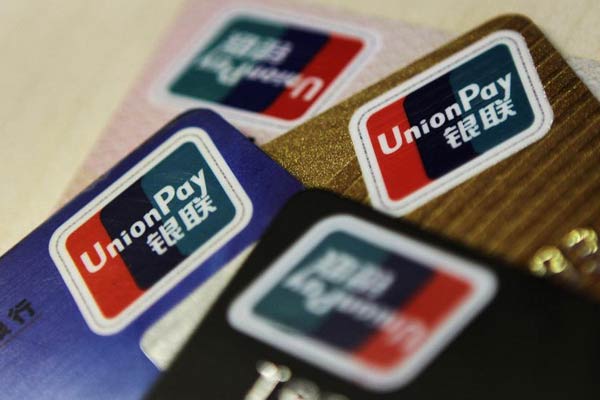Logos of China UnionPay are seen on bank cards in this file photo illustration taken in Beijing Dec 5, 2013. [Photo/Agencies]
Editor's Note: As of today, China Daily is running a series of news analysis articles on the macro-economic policies that will help the country change from an export-led economy to one driven primarily by consumer spending. The following is the first in the series.

Transaction data from China UnionPay and Alibaba could be used as a gauge for the strength of China's expanding service and consumption sector, economists said, as traditional indicators become increasingly irrelevant.
UnionPay handles transactions for almost all of the nation's bank cards, while Alibaba runs the country's largest online sales platform. An index developed by Alibaba showed consumer prices in August quickening more than the government's official reading, while the Tsinghua-UnionPay Advisors Indices of spending at luxury hotels in China rose to a record in August. Both contrast with the Caixin Manufacturing Purchasing Managers Index, which slid to 47.2 in September-signaling a contraction in the sector-the lowest since March 2009.
While China's traditional growth engines of manufacturing and investment sputtered, the resilient service sector held up the overall economy that otherwise would have fallen precipitously.
However, while there are various, frequently updated indicators for traditional growth engines, economists are largely left in dark about how healthy the service sector is due to the insufficiency of reliable data.
This is a major reason why China's second quarter GDP data encountered huge skepticism, given the vast incongruence between it and the sagging industrial production data. Chinese officials are quick to rebuke the outdated fixation on these "old-engine" data as the economy is undergoing a profound structural change-shifting away from investment and manufacturing to consumption and service.
For services, the most relevant official monthly data are retail sales, but economists fret over the flatness of the indicator, which doesn't reflect the volatility of prices.
Another widely-recognized indicator is the nonmanufacturing Purchasing Managers Index released by official and private agencies.
However, analysts said the PMI is based on surveys of purchasing managers, and the sampling of different enterprises can affect the reading. For example, official and private PMI results often suggest different directions in the economy, as the former is based more on large State firms while the latter focuses more on small private firms.
"There is always a conflict between the official PMI and private PMI," said Gan Jie, a finance professor with the Cheung Kong Graduate School of Business, adding that the question remains whether the economy is getting better or worse.
Gan said compared to industrial firms, the service sector is much more diverse and heterogeneous, and so gauging it in the same way is difficult.
"Input of industrial firms is homogeneous, such as electricity. Other metrics such as new orders, inventory levels, supplier deliveries, can be applied to firms in various industries. In the service sector it is difficult to find indicators that simultaneously apply to education, healthcare and tourism," she said.
To grasp the monthly fluctuation of China's GDP, Morgan Stanley analysts developed a "headline indicator" that factored in six indicators: electricity production, steel production, fiscal revenue, imports and exports, and car sales. These alternative indicators, they believe, tell more about the real state of the economy than GDP.
Another widely-used indicator is the "Li Keqiang index", a method inspired by the premier's way of gauging the real economy that factors in bank loans, electricity production and railway freight volume.
The attempt to develop a similar headline indicator in the service sector is still under way. "We are desperately looking for ways to gauge the service sector. The problem is they lack reliable, high-frequency subindexes in this area," said Qiao Hong, chief China economist for Morgan Stanley.
